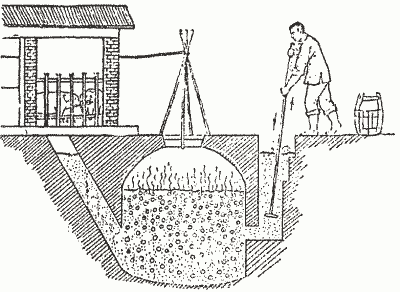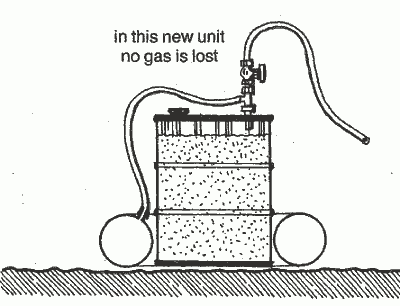DIY Biogas Plant
Posted by Krzysztof Lis on July 11, 2010
If you ever wondered how is it possible to make biogas at home, than you just found the right place. ![]() I’m going to show you two great books to read if you ever wanted to make biogas.
I’m going to show you two great books to read if you ever wanted to make biogas.
Biogas production, also known as anaerobic digestion, is a process in which a biodigestible matter (biomass) is transformed by bacteria to biogas. It is done in reactors called biodigesters, which you feed with all the waste biomass (cut grass, waste water — especially blackwater, . The remaining digestate is very nutrient-rich and can be used as a fertilizer. Because of that, I believe that anaerobic digestion is a better way to utilize waste biomass than composting, as the latter only produces fertilizer. Anaerobic digestion produces both fertilizer and biogas.
I posted here two years ago a short video on how to make small amounts of biogas, but today I will show you much better ways to make this fuel. ![]()
Many people think that it is difficult to produce biogas, but they’re wrong. If it was difficult, than China wouldn’t have more than 5 milions (!!) working and effective, yet very simple biodigesters. In China biogas plants are very popular way to utilize human, animal and plant waste. And are very easy to build.
Underground biogas plant
The first biodigester design I wanted to show you, is the underground pit with three openings. One to feed the waste biomas, second to remove the digestate. The third is used to supply the biogas to your house. The produced biogas is stored inside the pit, in the large chamber, above the surface of biodigestible material, and supplied from there when needed.

Simple chinese biogas plant.

The image above was taken from a great book “A Chinese Biogas Manual” by Ariane van Buuren, published by Knowledge Publications as the third volume of the Biogas series. The book shows a bit of introduction to the idea of biogas production in China and describes in detail building of such simple biogas pit. Many different designs are shown, based on different materials available to use: stone slabs, hewn stone, brick or concrete.
For example, to build a biogas pit of 10 cubic meters (353 cu.ft.) capacity you need:
- 1,250 – 1,500 kg (2,755-3,306 lbs) of lime,
- 200 kg (441 lbs) of cement,
- 2 cubic meters (71 cu.ft) of sand,
- 6 cubic meters (212 cu.ft) of large and small stones.
This book not only describes in detail how to build a simple biogas plant, but also how to utilize the produced fuel. You’ll find there a couple of burner designs (single tube burner, smoker’s pipe burner, spiral burner, long arm burner, showerhead burner, drum burner, revolving burner and several other designs), biogas stoves and even biogas lamps!
Of course the book contains a lot of important stuff about safety measures in both biogas production and use. You can buy it at Amazon.com for less than $20.
Drum-and-inner-tube-type
If you’d like to start with something easier to build in your backyard, you should consider another design, that utilizes one steel drum and one or more rubber inner tubes. The biodigestible matter is supplied to the drum and the biogas is stored in the inner tube(s). This design is not suitable for continuous use, after one batch of waste biomass is digested you have to empty the drum and fill it again with fresh feedstock.

Even simpler biogas plant, very easy to do it yourself from scratch.

This design is shown in full-detail in the second book I wanted to recommend, also published by Knowledge Publications, as the vols. 1&2 of Biogas series: “Biogas — what it is, how it is made, how to use it” and “Biogas 2 — building a better biogas unit”. Both books were prepared by FAO as a part of Better Farming Series and are fit inside one cover. If you ever read any book by FAO than you probably know how detailed those books are and how simply they’re written. No wonder, as they were written to be used all over the worlds, even in the smallest communities.
The design shown in the picture above was taken from the second book. As biogas is produced best in temperatures above the typical ambient temperature for Europe, Asia or North America, the book also describes good ways to insulate the biodigester. Two designs are shown, the better with drum and inner tube and the easier consisting of two drums of different size (one smaller put inside the second, larger). The simpler desing is a bit worse as some biogas is lost during operation.
The book can be purchased at Amazon.com for about $15.
Why produce biogas?
With one cubic meter (35 cu.ft.) of biogas you can:
- produce 1.25 kWh of electricity,
- substitute 0.7 kg of petrol,
- cook 3 meals for a family of 5-6,
- run 1 HP motor for 2 hours.
Is it really feasible not to use biogas, especially in off-grid locations? So when are you going to start making biogas?
Comments
9 Responses to “DIY Biogas Plant”Leave a comment, and if you'd like your own picture to show up next to your comments, go get a gravatar!
Iam final year project student,undertakng a project of underground biodigester.
I need an advise on choosing which method to use,ie using tank or digging underground.
@Najib: I would go for the tank method as it requires a lot less work, than digging that large hole underground.
Hello,
I have been doing my biogas for some times now, it has no leaks, and lots of bubble are forming, but the air I got does not light any flame, can you help me?
plc advice me on biogas reaserch method!veternary student graduation project
@Bye Fareed: probably you get only CO2 gas, which happens if you provide air supply to the fermentation.
I see that you recomend above ground builds rather than under ground instalations. Well there are many additional benifits to be gained from an underground install I.E. High levels of heat production and retention this alone can be wirth its weight in gold. Bio-Gold In these under ground installs you can add features that will alow you to grow feed stocks ( cat fish, vegitables ) for human consumption. Generate heat for space, & water heating. Disposal of usualy undesirable human and other waist products.
These can be transformed through these systems into by products that have great value and benifits. and through the use of mutipul digester globes together you can have non stop production of all of these benifits. In the under ground globe design that I am refering to you dont need to add gas storage or gas compresion as the globe both stores and build presure on the gas. Also in a twin install the second digester chamber can act as secondary gas storage if needed. TAG z 333 9 @ ya hoo . com
Hi, my biogas generator is 3 week today and has been producing gas not lit what can i do?